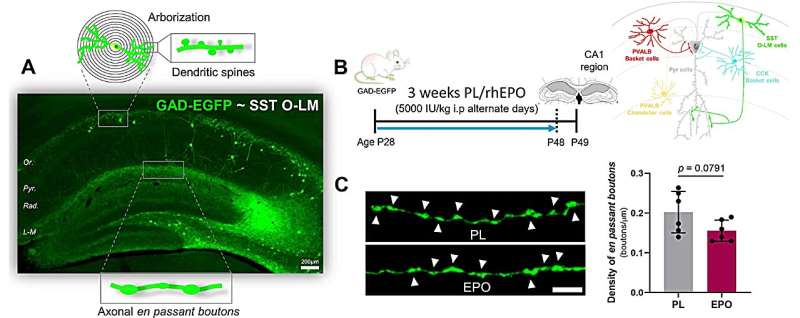
A new study that including participants from the Central Institute of Mental Health in Mannheim shows how the growth factor erythropoietin (EPO) protects and regenerates nerve cells in the brain. In particular, the important role of interneurons has now been clarified. The findings could potentially be of significance in neuropsychiatric disorders and enable new therapeutic approaches in the future.
Neuropsychiatric diseases, such as schizophrenia, multiple sclerosis, depression or autism spectrum disorders, are associated with cognitive impairments and a disturbed balance of excitation and inhibition in the brain. EPO not only promotes the formation of red blood cells, but also protects and regenerates nerve cells in the brain.
EPO could therefore play an important role in alleviating neuropsychiatric disorders, as studies on young mice provide information on how EPO can help to repair and maintain transcriptional networks in the hippocampus and synaptic structures on pyramidal neurons. However, it was previously not understood how EPO regulates excitatory synapses involving interneurons. Interneurons are nerve cells of the central nervous system that interconnect other nerve cells.
Molecular atlas of hippocampal interneurons
In a study now published in the journal Molecular Psychiatry, an international team of researchers including the Central Institute of Mental Health (CIMH) in Mannheim was able to demonstrate these connections. By analyzing about 12,000 transcriptomic single-cell nuclear data, the researchers were able to create a comprehensive molecular atlas of hippocampal interneurons and identify 15 interneuron subtypes.
“We then investigated molecular remodeling under so-called recombinant human (rh)EPO and found that the primary molecular changes affect the way genes are activated and thus have an impact on important processes in the brain,” says Prof. Dr. Dr. Hannelore Ehrenreich, head of the Experimental Medicine research group at the CIMH. The scientist has been investigating the role of EPO in the brain for many years.
Interactions of nerve cells influenced
Specifically, the researchers found that rhEPO changes the structure of the connections between nerve cells, the synaptic transmission of signals and the degradation of molecules within the cells. It appears that rhEPO influences the interactions between certain types of nerve cells, particularly between pyramidal cells and inhibitory interneurons.
The experiments, conducted both in the laboratory and in living mice, have shown that certain groups of neurons, specific interneuron populations, exhibit less complex connections and less synaptic activity when exposed to rhEPO. Changes in key molecules that are important for brain plasticity were also detected.
Metabolic processes and the ability of some interneuron groups to inhibit other neurons are impaired by rhEPO. “This causes the pyramidal cell, a type of neuron in the brain that is very important for cognitive functions, to perform better,” comments Dr. Manvendra Singh, a computational biologist who was also involved in the study.
“In summary, the improvement of neuropsychiatric symptoms by rhEPO is partly due to its restrictive control of interneurons, which facilitates the restoration of healthy connectivity and synapse development,” says Ehrenreich.
The findings are an important step toward further understanding the interactions of EPO in the brain and could pave the way for new therapeutic approaches for various neuropsychiatric disorders.
More information:
Yasmina Curto et al, Erythropoietin restrains the inhibitory potential of interneurons in the mouse hippocampus, Molecular Psychiatry (2024). DOI: 10.1038/s41380-024-02528-2
Provided by
Zentralinstitut für Seelische Gesundheit
Citation:
Molecular atlas shows how the growth factor erythropoietin affects neurons (2024, April 18)
molecular-atlas-growth-factor-erythropoietin.html
.
. The content is provided for information purposes only.
